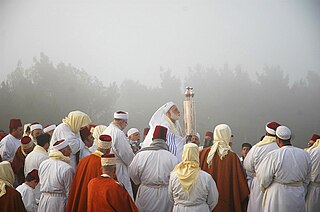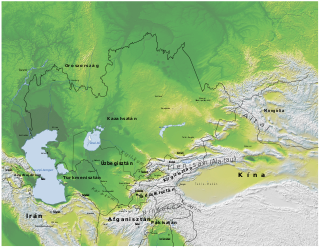Related Research Articles

Anatolia, historically known as Asia Minor, is a large peninsula in Western Asia and is the western-most extension of continental Asia. The land mass of Anatolia constitutes most of the territory of contemporary Turkey. Geographically, the Anatolian region is bounded by the Turkish Straits to the north-west, the Black Sea to the north, the Armenian Highlands to the east, the Mediterranean Sea to the south, and the Aegean Sea to the west. Topographically, the Sea of Marmara connects the Black Sea with the Aegean Sea through the Bosporus strait and the Dardanelles strait, and separates Anatolia from Thrace in the Balkan peninsula of Southeastern Europe.

Galatia was an ancient area in the highlands of central Anatolia, roughly corresponding to the provinces of Ankara and Eskişehir, in modern Turkey. Galatia was named after the Gauls from Thrace, who settled here and became a small transient foreign tribe in the 3rd century BC, following the Gallic invasion of the Balkans in 279 BC. It has been called the "Gallia" of the East.

Lydia was an Iron Age kingdom of western Asia Minor located generally east of ancient Ionia in the modern western Turkish provinces of Uşak, Manisa and inland Izmir. The ethnic group inhabiting this kingdom are known as the Lydians, and their language, known as Lydian, was a member of the Anatolian branch of the Indo-European language family. The capital of Lydia was Sardis.

The Septuagint, is the earliest extant Greek translation of the Hebrew Bible from the original Hebrew. The full title derives from the story recorded in the Letter of Aristeas to Philocrates that "the laws of the Jews" were translated into the Greek language at the request of Ptolemy II Philadelphus by seventy-two Jewish translators—six from each of the Twelve Tribes of Israel.

Samaritans are an ethnoreligious group who originate from the ancient Israelites. They are native to the Levant and adhere to Samaritanism, an Abrahamic and ethnic religion.

The Alans were an ancient and medieval Iranian nomadic pastoral people of the North Caucasus – generally regarded as part of the Sarmatians, and possibly related to the Massagetae. Modern historians have connected the Alans with the Central Asian Yancai of Chinese sources and with the Aorsi of Roman sources. Having migrated westwards and becoming dominant among the Sarmatians on the Pontic–Caspian steppe, the Alans are mentioned by Roman sources in the 1st century CE. At that time they had settled the region north of the Black Sea and frequently raided the Parthian Empire and the Caucasian provinces of the Roman Empire. From 215–250 CE the Goths broke their power on the Pontic Steppe.

Shechem, also spelled Sichem, was a Canaanite and Israelite city mentioned in the Amarna Letters, later appearing in the Hebrew Bible as the first capital of the Kingdom of Israel following the split of the United Monarchy. According to Joshua 21:20–21, it was located in the tribal territorial allotment of the tribe of Ephraim. Shechem declined after the fall of the northern Kingdom of Israel. The city later regained its importance as a prominent Samaritan center during the Hellenistic period.

The History of North Africa during the period of Classical Antiquity can be divided roughly into the history of Egypt in the east, the history of Ancient Libya in the middle and the history of Numidia and Mauretania in the West.
The Scordisci were a Celtic Iron Age cultural group centered in the territory of present-day Serbia, at the confluence of the Savus (Sava), Dravus (Drava), Margus (Morava) and Danube rivers. They were historically notable from the beginning of the third century BC until the turn of the common era, and consolidated into a tribal state. At their zenith, their core territory stretched over regions comprising parts of present-day Serbia, Croatia, Bulgaria and Romania, while their influence spread even further. After the Roman conquest in the 1st century AD, their territories were included into the Roman provinces of Pannonia, Moesia and Dacia.

Indo-Scythians were a group of nomadic Iranian peoples of Scythian origin who migrated from Central Asia southward into modern day Pakistan and Northwestern India from the middle of the 2nd century BCE to the 4th century CE.

The Massagetae or Massageteans, also known as Sakā tigraxaudā or Orthocorybantians, were an ancient Eastern Iranian Saka people who inhabited the steppes of Central Asia and were part of the wider Scythian cultures.

The Senones or Senonii were an ancient Gallic tribe dwelling in the Seine basin, around present-day Sens, during the Iron Age and the Roman period.

Indo-Iranian peoples, also known as Indo-Iranic peoples by scholars, and sometimes as Arya or Aryans from their self-designation, were a group of Indo-European peoples who brought the Indo-Iranian languages, a major branch of the Indo-European language family, to major parts of Eurasia in the second part of the 3rd millennium BCE. They eventually branched out into Iranian peoples and Indo-Aryan peoples, predominantly in the geographical subregion of Southern Asia.
Madyes was a Scythian king who ruled during the period of the Scythian presence in West Asia in the 7th century BCE. Madyes was the son of the Scythian king Bartatua and the Assyrian princess Serua-eterat, and, as an ally of the Neo-Assyrian Empire, which was then the superpower of West Asia and whose king Ashurbanipal was his uncle, he brought Scythian power to its peak in West Asia.

Kythnos, commonly called Thermia, is a Greek island and municipality in the Western Cyclades between Kea and Serifos. It is 56 nautical miles (104 km) from the Athenian harbor of Piraeus. The municipality Kythnos is 100.187 km2 (38.68 sq mi) in area and has a coastline of about 100 km (62 mi). Mount Kakovolo is island's highest peak (365m).
Treri is the name of a Thracian tribe.

Cappadocia was a Hellenistic-era Iranian kingdom centered in the historical region of Cappadocia in Asia Minor. It developed from the former Achaemenid satrapy of Cappadocia, and it was founded by its last satrap, Ariarathes. Throughout its history, it was ruled by three families in succession; the House of Ariarathes (331–96 BC), the House of Ariobarzanes (96–36 BC), and lastly that of Archelaus (36 BC–17 AD). In 17 AD, following the death of Archelaus, during the reign of Roman emperor Tiberius (14–37 AD), the kingdom was incorporated as a Roman province.
Leucae or Leuce was a small town of ancient Ionia, in the neighbourhood of Phocaea. Leucae was situated, according to Pliny in promontorio quod insula fuit, or, "on an island promontory." From Scylax we learn that it was a place with harbours. According to Diodorus, the Persian admiral Tachos founded this town on an eminence on the sea coast, in 352 BCE; but shortly after, when Tachos had died, the Clazomenians and Cymaeans quarrelled about its possession, and the former succeeded by a stratagem in making themselves masters of it. At a later time Leucae became remarkable for the battle fought in its neighbourhood between the consul Publius Licinius Crassus Dives Mucianus and Aristonicus in 131 BCE. Some have supposed this place to be identical with the Leuconium mentioned by Thucydides; but this is impossible, as this latter place must be looked for in Chios. The site of the ancient Leucae is at Üçtepeler, Izmir Province, Turkey, some distance from the coast. Coins were minted at Leucae in the 3rd century BCE.

Isaura Palaea, in Latin Isaura Vetus, both meaning 'Old Isaura', and perhaps identical to Isauropolis, was a Roman and Byzantine era town in southern Turkey. The city has been identified with modern Zengibar Kalesi near Konya.
Pordoselene or Poroselene (Ποροσελήνη) was a town and polis (city-state) of ancient Aeolis. It was located on the chief island of the Hecatonnesi, a group of small islands lying between Lesbos and the coast of Asia Minor, which was also called Prodoselene. Strabo says that some, in order to avoid the dirty allusion presented by this name, as pordos means fart in Greek, called it Poroselene, which is the form employed by Ptolemy, Pliny the Elder, and Aelian. At a still later time the name was changed into Proselene, under which form the town appears as a bishop's see. Aristotle mentions the town in his History of Animals where it was on the extremity of a road that formed the border between an area of the island that contained weasels and another area that did not have them.
References
 This article incorporates text from a publication now in the public domain : Smith, William, ed. (1854–1857). Dictionary of Greek and Roman Geography . London: John Murray.
This article incorporates text from a publication now in the public domain : Smith, William, ed. (1854–1857). Dictionary of Greek and Roman Geography . London: John Murray.{{cite encyclopedia}}: Missing or empty|title=(help)
